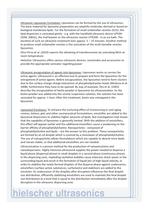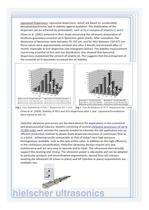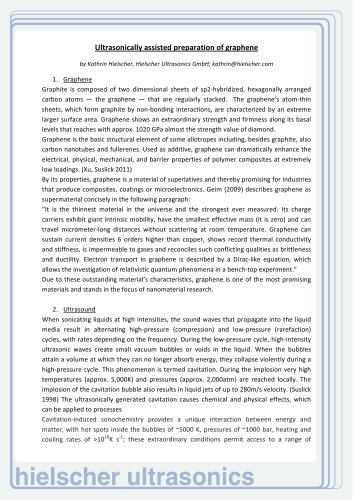
Catalog excerpts

Hielscher Ultrasonics – Your Expert for Ultrasonic Processes Hielscher Ultrasonics: Ultrasonic Liposome Preparation for Pharmaceuticals and Cosmetics Kathrin Hielscher, Hielscher Ultrasonics GmbH Liposomes (liposome-lipid based vesicles), transferosomes (ultradeformable liposomes), ethosomes (ultradeformable vesicles with high alcohol content), and niosomes (synthetic vesicles) are microscopic vesicles, which can be artificially prepared as globular carriers into which active molecules can be encapsulated. These vesicles with diameters between 25 and 5000 nm are often used as drug carriers for topical purposes in the pharmaceutical and cosmetic industry, such as drug delivery, genetherapy, and immunization. Ultrasound is a proven method of liposome preparation and the encapsulation of active agents into these vesicles. Liposomes: Liposomes are unilamellar, oligolamellar or multilamellar vesicular systems and are composed of the same material as a cell membrane (lipid bilayer). Regarding to their composition and size, one differs between multi-lamellar vesicles (MLV, 0.110μm) and unilamellar vesicles, which are distinguished between small (SUV, <100 nm), large (LUV, 100–500 nm) or giant (GUV, ≥1 μm) vesicles. The composite structure of liposomes consists of phospholipids. Phospholipids have a hydrophilic head group and a hydrophobic tail group, which consists of a long hydrocarbon chain. The liposome membrane has a very similar composition as the skin barrier, so that they can be easily integrated into the human skin. As the liposomes fusionate with the skin, they can unload the entrapped agents directly to the destination, where the actives can fulfill their functions. Thus, the liposomes create an enhancement of skin penetrability/ permeability for the entrapped pharmaceutical and cosmetical agents. Also liposomes without encapsulated agents, the vacant vesicles, are potent actives for the skin, as the phosphatidylcholin incorporates two essentials, which the human organism cannot produce by itself: linoleic acid and choline. Chemical stucture of hydrogenated phosphatidylcholine Liposomes are used as biocompatible carriers of drugs, peptides, proteins, plasmic DNA, antisense oligonucleotides or ribozymes, for pharmaceutical, cosmetic, and biochemical purposes. The enormous versatility in particle size and in physical parameters of the lipids affords an attractive potential for constructing tailor-made vehicles for a wide range of applications. (Ulrich 2002)
Open the catalog to page 1
Ultrasonic Liposomes Formation: Liposomes can be formed by the use of ultrasonics. The basic material for liposome preperation are amphilic molecules derived or based on biological membrane lipids. For the formation of small unilamellar vesicles (SUV), the lipid dispersion is sonicated gently - e.g. with the handheld ultrasonic device UP50H (50W, 30kHz), the VialTweeter or the ultrasonic reactor UTR200 - in an ice bath. The duration of such an ultrasonic treatment lasts approx. 5 – 15 minutes. Another method to produce small unilamellar vesicles is the sonication of the multi-lamellar...
Open the catalog to page 2
Liposomal Dispersions: Liposomal dispersions, which are based on unsaturated phosphatidylchlorine, lack in stability against oxidation. The stabilization of the dispersion can be achieved by antioxidants, such as by a complex of vitamins C and E. Ortan et al. (2002) achieved in their study concerning the ultrasonic preparation of Anethum graveolens essential oil in liposomes good results. After sonication, the dimension of liposomes were between 70-150 nm, and for MLV between 230-475 nm; these values were approximately constant also after 2 month, but inceased after 12 month, especially in...
Open the catalog to page 3
Dayan, Nava (2005): Delivery System Design in Topically Applied Formulations: An Overview. In: Delivery system handbook for personal care and cosmetic products: Technology, Applications, and Formulations (edited by Meyer R. Rosen). Norwich, NY: William Andrew; p. 102-118. Dinu-Pirvu, Cristina; Hlevca, Cristina; Ortan, Alina; Prisada, Razvan (2010): Elastic vesicles as drugs carriers though the skin. In: Farmacia Vol.58, 2/2010. Bucharest. Domb, Abraham J. (2006): Liposheres for Controlled Delivery of Substances. In: Microencapsulation – Methods and Industrial Applications. (edited by Simon...
Open the catalog to page 4All Hielscher catalogs and technical brochures
-
Ultrasonic Process Lab
1 Pages
-
Ultrasonic Wire Cleaning
4 Pages
-
Ultrasonic Applications
1 Pages
-
Hielscher Ultrasonic Sieves
2 Pages



















